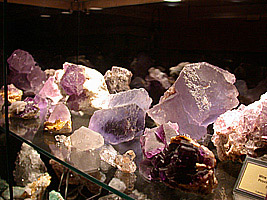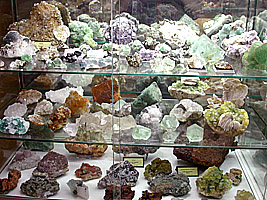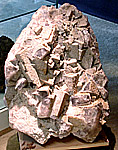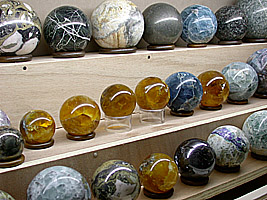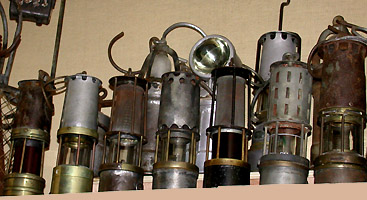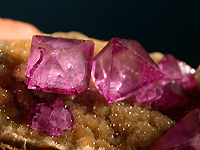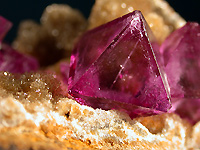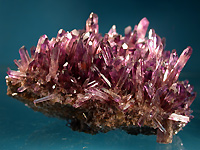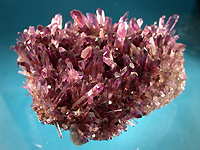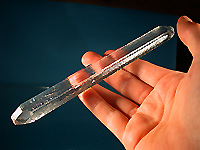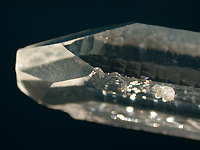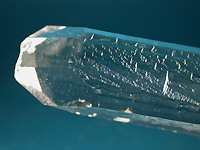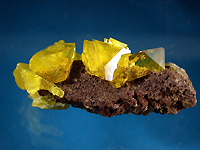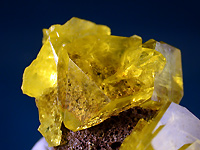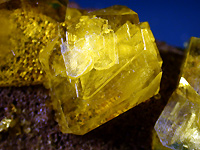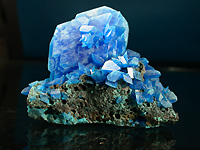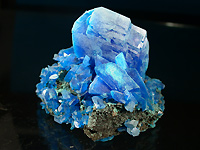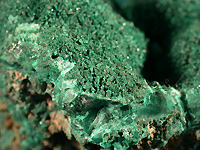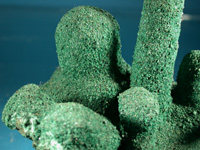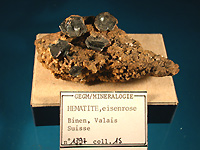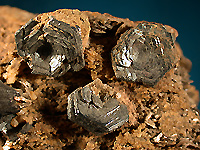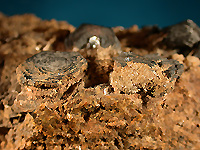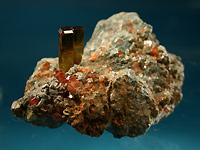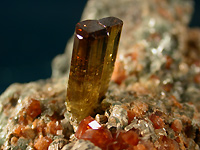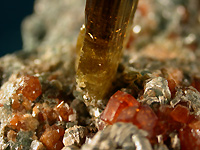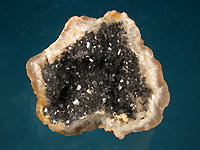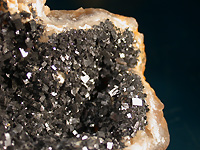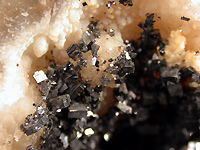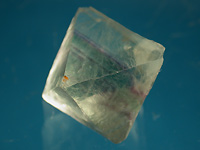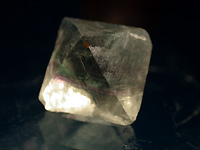| The
text presented here is not to make us play a role " upholders of the law"
in mineralogy, but just to show you some modifications, arrangements or forgeries(imitations)
which we are all susceptible to meet one day.
We
can distinguish several categories: The
synthesis: take some common salt ( NaCl), dissolve some grams in some
water (50ml and once the totally made dissolution, pour your mixture into a ramekin
which you will forget voluntarily on the height of a cupboard, for example (immovable
place - in theory!). When all the water will be evaporated, you will find beautiful
small cubic crystals. The same system, in the industrial scale (and with techniques
considerably more developed - Verneuil processing...) allows to form ruby crystals
(used in lasers), diamonds (very small and used as abrasive for saws)... We saw,
a few years ago, some crystals of copper sulphate which were spectacular but now
forbidden for sale because of young children poisoning.
| |
|
| Fluorite(?????)
Specimen from Eastern countries. No location given!!! |
In
the crystal, germs are visible... They are the base of the crystallization. |
| |
|
|
Some doubts can remain: this amethyst is a man-made specimen but the identification
is not easy. u |
|
|
|
|
Monocrystal
of synthetic quartz - 20 cms length u |
| |
|
|
Some
are specialized in crystal synthesis and are doing business. Above, a sulfate
of aluminium and magnesium which looks like some sulfur.
Everything is allowed
since we tell the truth! |
| |
|
"Common" synthetic chalcanthite, made from copper sulphate II solution.
The business would have been forbidden because of poisoning of young children
who would have put the crystal in the mouth... |
The
irradiated specimen: It is a question of giving a more "commercial"
appearance. The typical example is the morion quartz of Arkansas. Initially, it
is white, crystal clear and after gamma irradiation, it turns black and brilliant.
So, it is sold better thanks to some hours of human intervention... The natural
irradiation, on the other hand, takes several thousand years: morion quartz of
the "Massif Central", the alpine smoked quartz... How to recognize natural
irradiated of the artificial irradiated? We are only giving tracks... The
warmed specimen: Classic phenomenon and "successful candidate"
(under certain reserves, notably that to warn the buyer!) in gemology. The most
common examples are:
- amethyst: which we put in an oven during some hours, and which sets one
citrin colour. In fact, the heat in provoked a conversion of the Fe2 + ions ,
responsible of the purple color, in Fe3 + ions which give to the mineral the ochre-yellow
color (intensity of the tint which is a function of the concentration in iron
ions). The specimen is cut and sold thus then under the name of citrine logically,
the salesman should clarify if it is about the natural or artificial citrine.
What will not allow confusion, on the other hand, is the called, in French, "améthrine
" stone which is partially purple and which presents another pole citrine.
This mineral was formed in natural conditions and this is sure, because the means
to obtain these two colors artificially on the same crystal, was not found yet!
-
topaz: very blue, it is very possible that it was warmed. But there are
blue topazes not warmed in sharply rarer quantity...
The
examples are numerous... The
restuck specimen (in place):
it occurs for specimens of big rarity, either those to whom the collector will
attach a sentimental importance for example. Some pink fluorites of the "Mont
Blanc" were restuck in place on quartz smoked on which they had developed.
We can see also the example with the esmerald on gangue... The honesty would want
that we indicate this repair during the sale. It's the same for specimen with
strengthened gangue to avoid that all the specimen to be transformed into puzzle!
| |
|
" Malachited" malachite! Some powder of malachite was stuck on the specimen
which had defects (dings, breaks, damaged parts...).
The gangue is indeed
malchite, and the superior layer also but between both, there is a small layer
of glue! |
| |
|
|
A
hematite of Binen Valais-Suisse. A specimen can stay for a long time in collection
before the owner understand the trickery. Here, 3 roses of hematite (among 4!)
were restuck by means of a cement made with the dust of the gangue of the mineral.
The helping time (or not helping!), the color of the cement evolved and its texture
also... u |
The
stuck specimen..
with different minerals (the "mineralogical medley"):
we find them according to the mineralogical culture of the manufacturers. Indeed,
some will not dare to associate a fluorite to an agathe!!!! But others will dare
completely plausible more subtle associations: the association of 2 minerals of
same format, but from different places...
| |
|
|
|
The
specimen is very aesthetic but the main crystal was stuck on the gangue of garnets.
The joint was camouflaged with some powder of the gangue so that no smudge of
glue is visible.
|
In
the same genre and very common, we find the " Berber geodes ": these
are geodes of chalcedony whose mineralogical interest is limited, and on which
we papered the inside of galena cubes (different sizes for specimens more elaborated!).
This is made by depositing a film of glue then by placing some cubes obtained
by natural cleavage of the galena. The rest of the geode is then performed with
residues of cleavage (powder) of the galène, which are going to stick in
the not yet busy zones. It is the archetype of the "false specimen"...
| |
|
|
| |
Just above: Moroccan galena"crushed" stuck inside a geode of chalcedony.
The galena was fixed there where the glue was, and sometimes the carpet of galena
is not homogeneous (above right ). | |
A
NUANCE:
The use of the natural cleavages: this is mainly visible
with the fluorine. This one splits rather easily (with little knowledge of spliting!).
From a cube, we obtain an octahedron.
It is the major part of the octahedrons which are not on gangue, available on
the market. The advantage is to be able to obtain a correct crystalline shape
from a cube which was not useful because of knocks...
| |
|
Octahedron
of chinese fluorite. 3 cms edge. We can see zonations of colors which were paralells
in the initial faces of the cube. u |
The
modified specimen:
it is necessary to distinguish the the face and the back. Here, we only present
the mineralogical interesting face (example: the crystallized malachite). On the
other hand the work on the back of the specimen cannot be considered as a imitation. About
the modification of the crystallizations, this can be made by various chemical
and\or mechanical means. An example was a quartz which had undergone some small
shocks during its extraction. This specimen had an important value. To present
it without showingit has been hand modified, some fluorhydric acid had been used
to give a natural aspect to the breaks (*) DO
NOT MERGE WITH... The
work on the matrix(back of the specimen) : il nous semble indispensable
de parler ici de ce travail qui peut être effectué avec plus ou moins
de finesse, en fonction des moyens techniques dont on dispose.
Le collectionneur sur le terrain ne voudra pas s'encombrer de kilogrammes superflus,
surtout s'il se trouve à bonne distance de son moyen de locomotion. Aussi
n'hésitera t'il pas à user de ses outils pour faire partir un morceau
de gangue. Si cela s'avère trop risqué, le travail pourra être
fait à l'aide d'une scie diamantée. Mais il est vrai que certains
n'apprécient pas de voir une pièce à l'envers bien droit
et lisse. Cela se comprend.
C'est pourquoi il existe un système dit
de "blastage" (sorte de sablage avec des grains plus ou moins fins),
qui permet d'attaquer la gangue à l'endroit où elle a été
sciée, pour lui redonner un aspect naturel (cassure, zone de contact...).
Ceci n'est en aucune façon un "traffic" de mineral. Les marchands
de tels systèmes sont bien représentés et présentent
leur matériel sur certaines bourses internationales... Le
nettoyage des minéraux : Là aussi, certains puristes
diront qu'un minéral ne doit pas être nettoyé, et présenté
tel qu'il a été trouvé. Il est extrêmement rare de
trouver un minéral qui ne soit pas sali, soit par des oxydes de fer, soit
par de la "boue", ou bien par d'autres produits secondaires qui découlent
de l'altération de la roche encaissante et qui sont plus ou moins tenaces.
Une fluorine (par exemple!), aussi belle et brillante soit-elle, sous une couche
d'oxydes de fer ne présente aucun intérêt. Pour cela des produits
divers peuvent être utilisés. Le plus difficile est d'utiliser celui
(ou ceux) qui n'ont pas d'action destructrice sur la cristallisation qui nous
intéresse... La Revue "Le Règne Minéral" présente
depuis le mois de juin 2004 des méthodes de nettoyage. Nous
parlions d'utilisation d'acides pour mettre en valeur des pièces minéralogiques.
Certes, il peut y avoir une dérive comme mentionnée ci dessus (voir
*), mais son utilisation est particulièrement bien adaptée pour
dissoudre le quartz de certain échantillons qui seraient invibles sans
ce procédé. A titre d'exemple, nous pouvons prendre les derniers
octaèdres de fluorine chinoise qui sont initialement noyés dans
le quartz. Leur couleur bleu-vert est ainsi mise en valeur. Mais ceci s'est également
vu pour quelques rares pièces de fluorine et barytine du Maroc qui étaient
dissiulées sous plus d'un centimètre de quartz marron, sale... et
sans aucun intérêt minéralogique. Ainsi,
et nous le répétons, ceci n'a pour but que de developper un petit
peu l'esprit critique du lecteur. Nous n'avons pas la prétention de tout
savoir, mais nous tenons juste à informer quant aux surprises que l'on
peut découvrir... Par
ailleurs, si vous êtes en posséssion d'un"faux" ou specimen
qui n'est pas "conforme aux lois naturelles", vous pouvez aussi nous
le faire savoir. Spathfluor se fera un plaisir d'enrichir cette rubrique... en
restant discret, cela va de soi!
Remerciements aux collectionneurs qui nous ont confié
leurs échantillons. 
Back |
